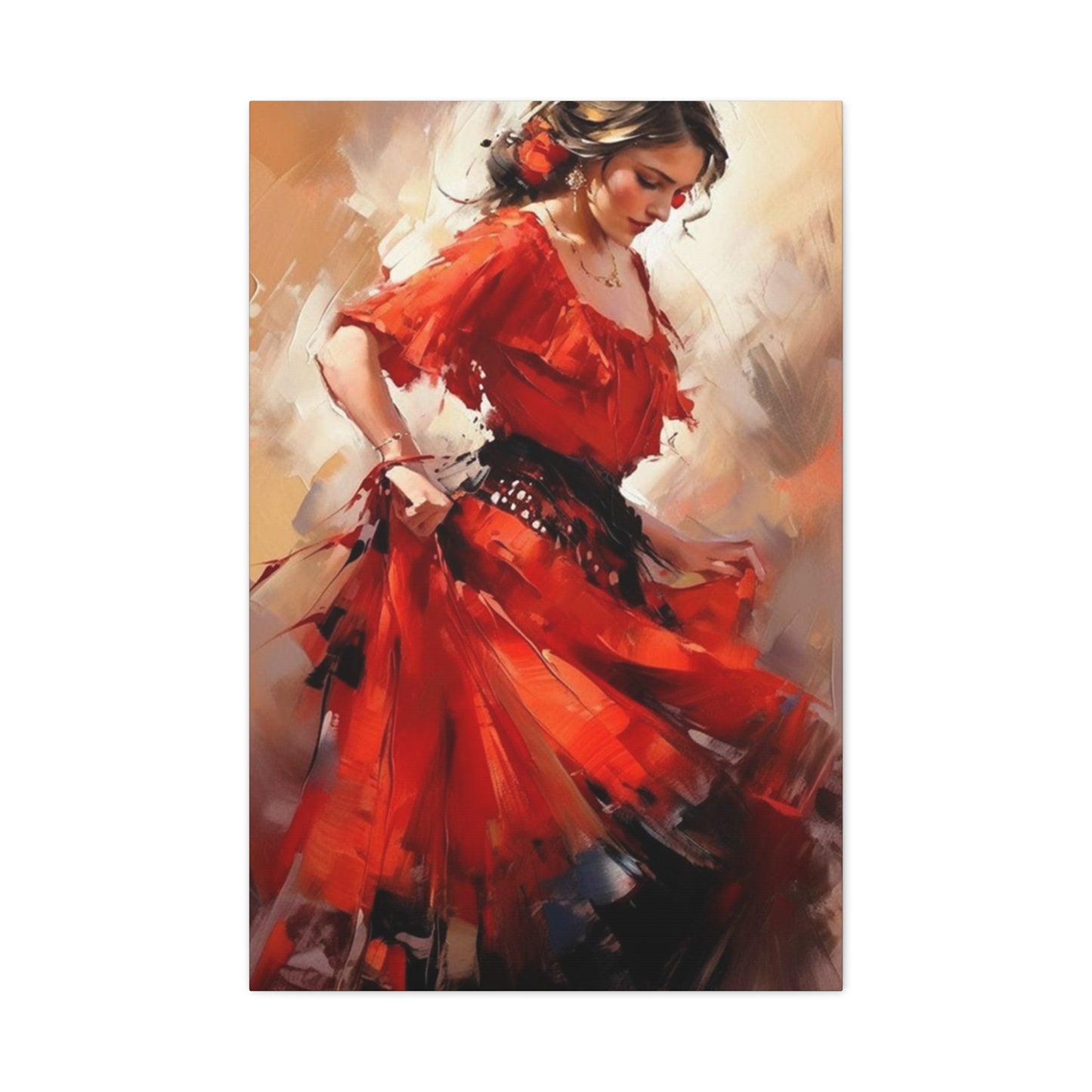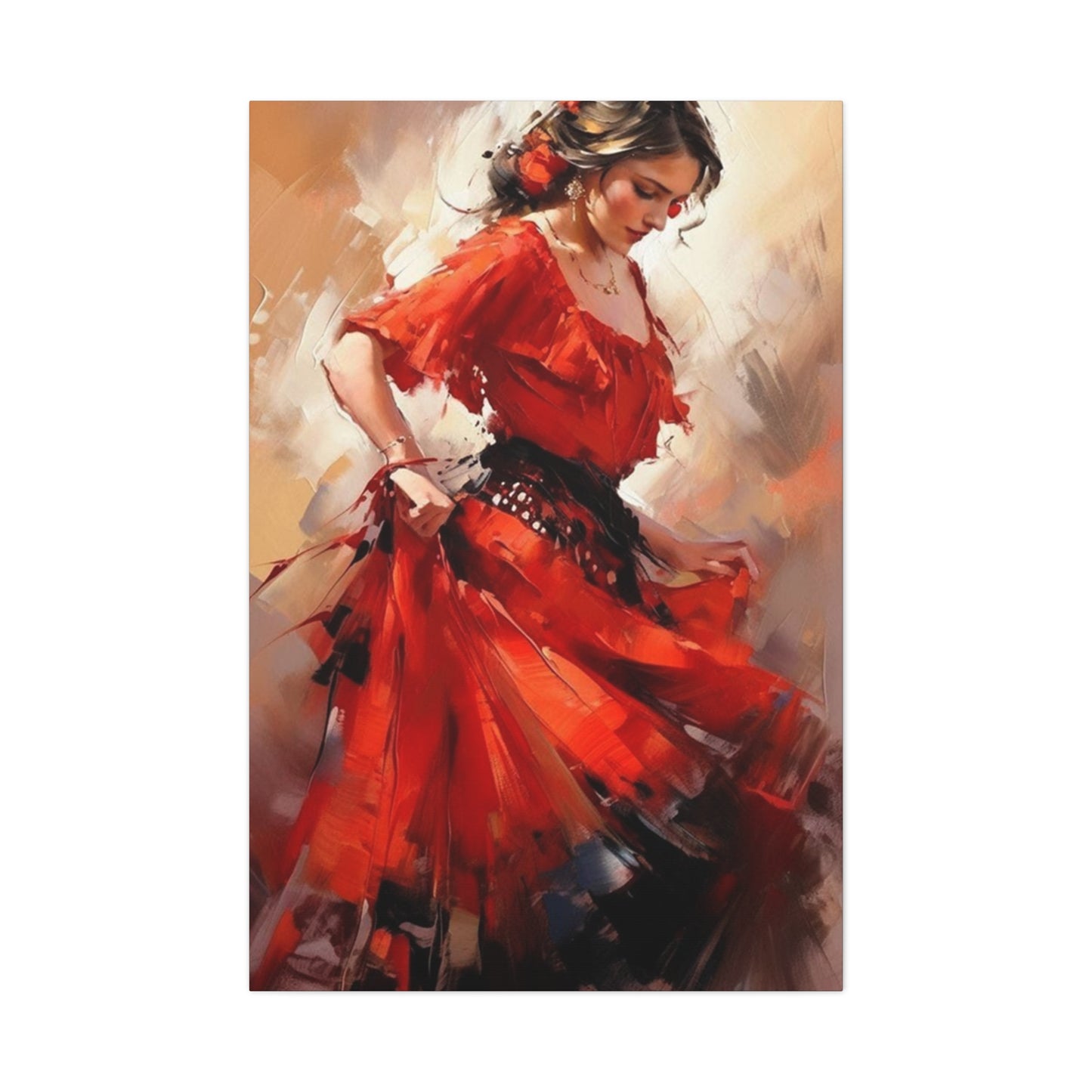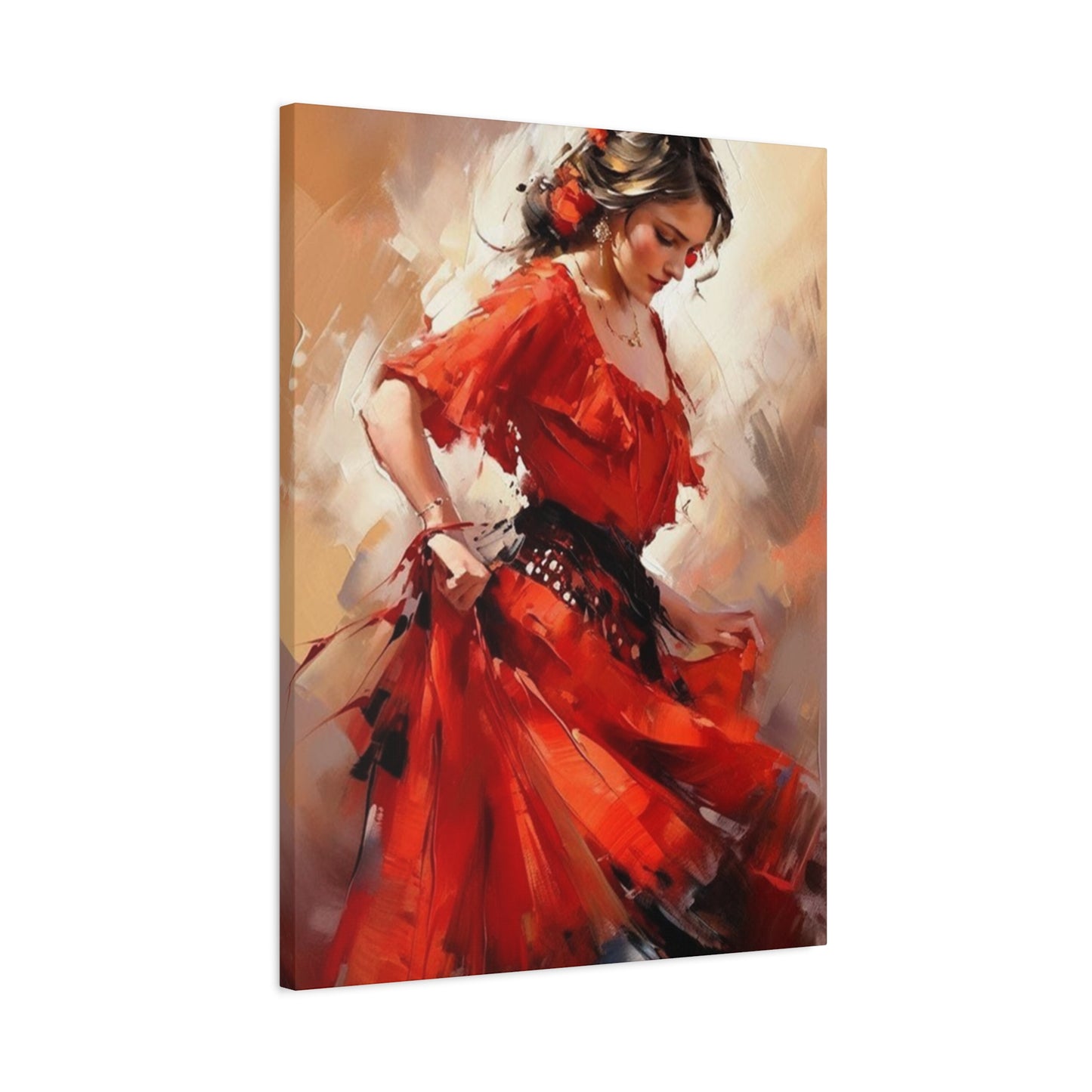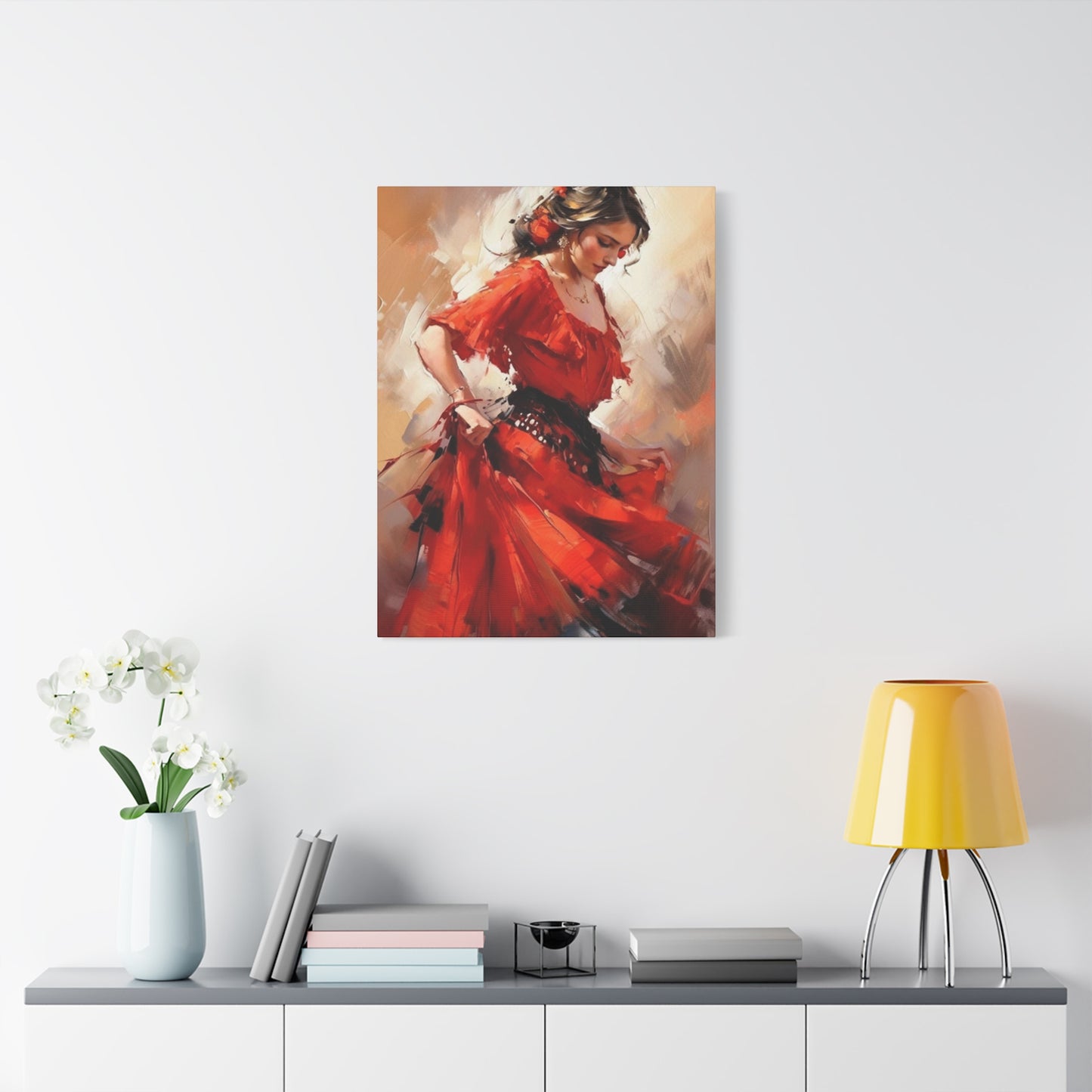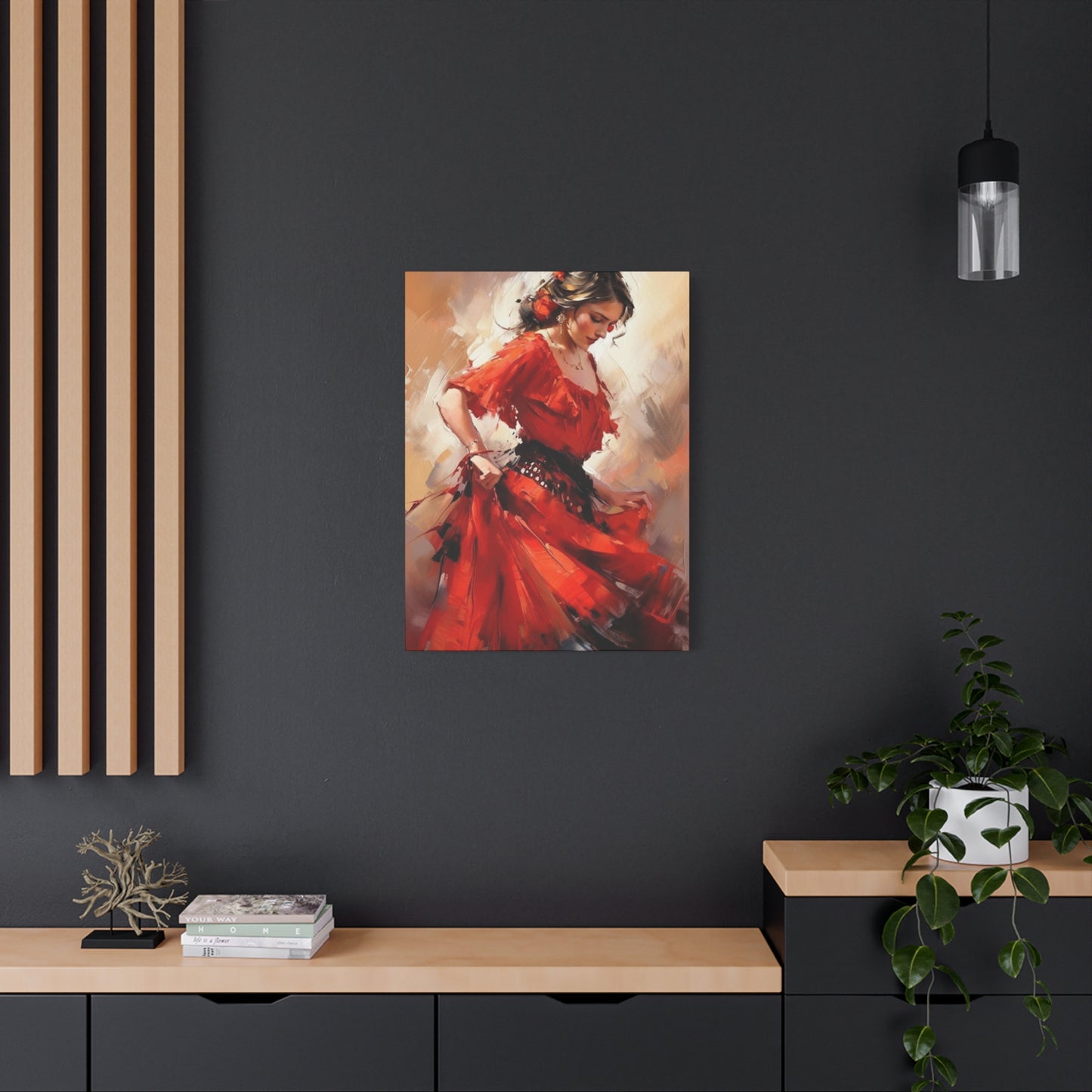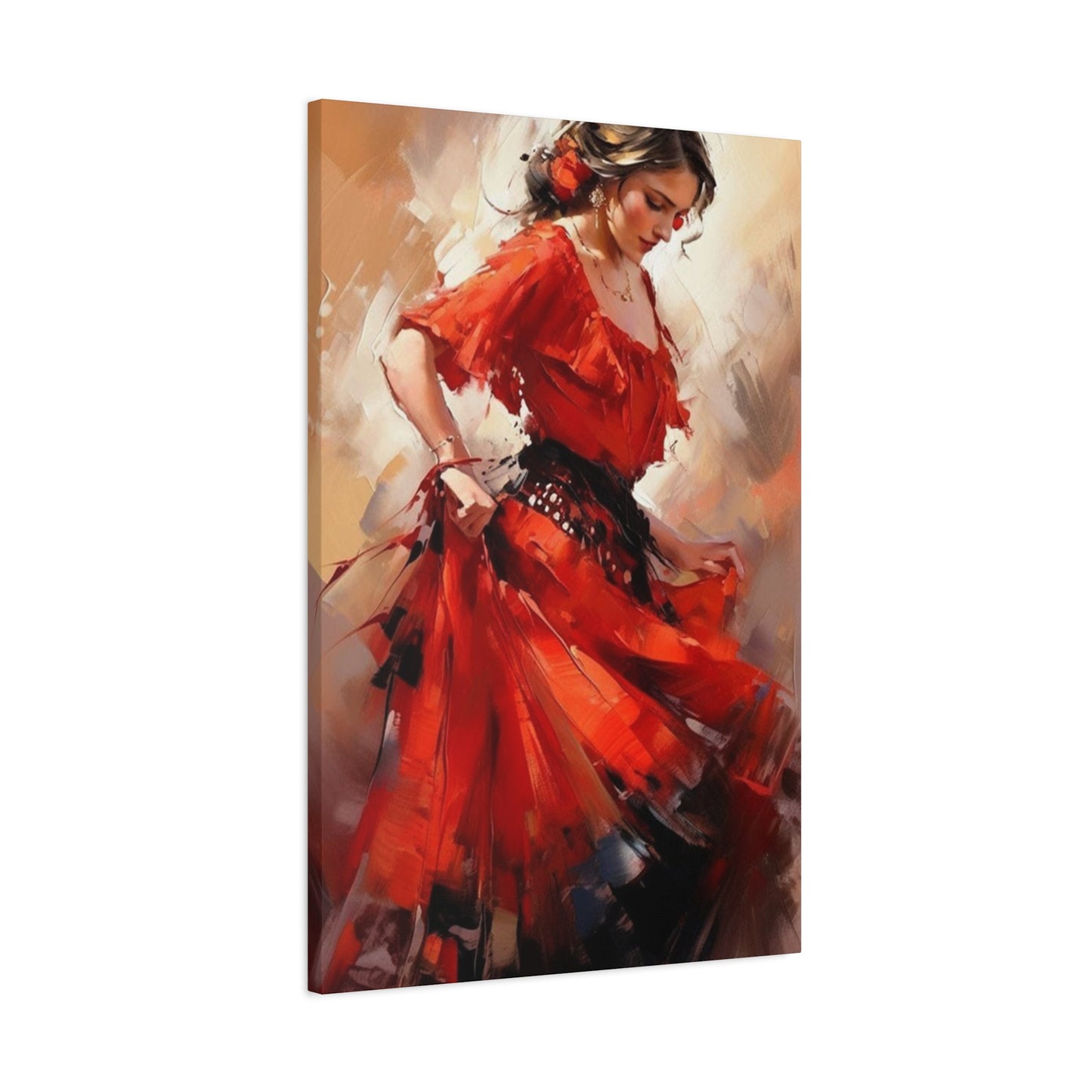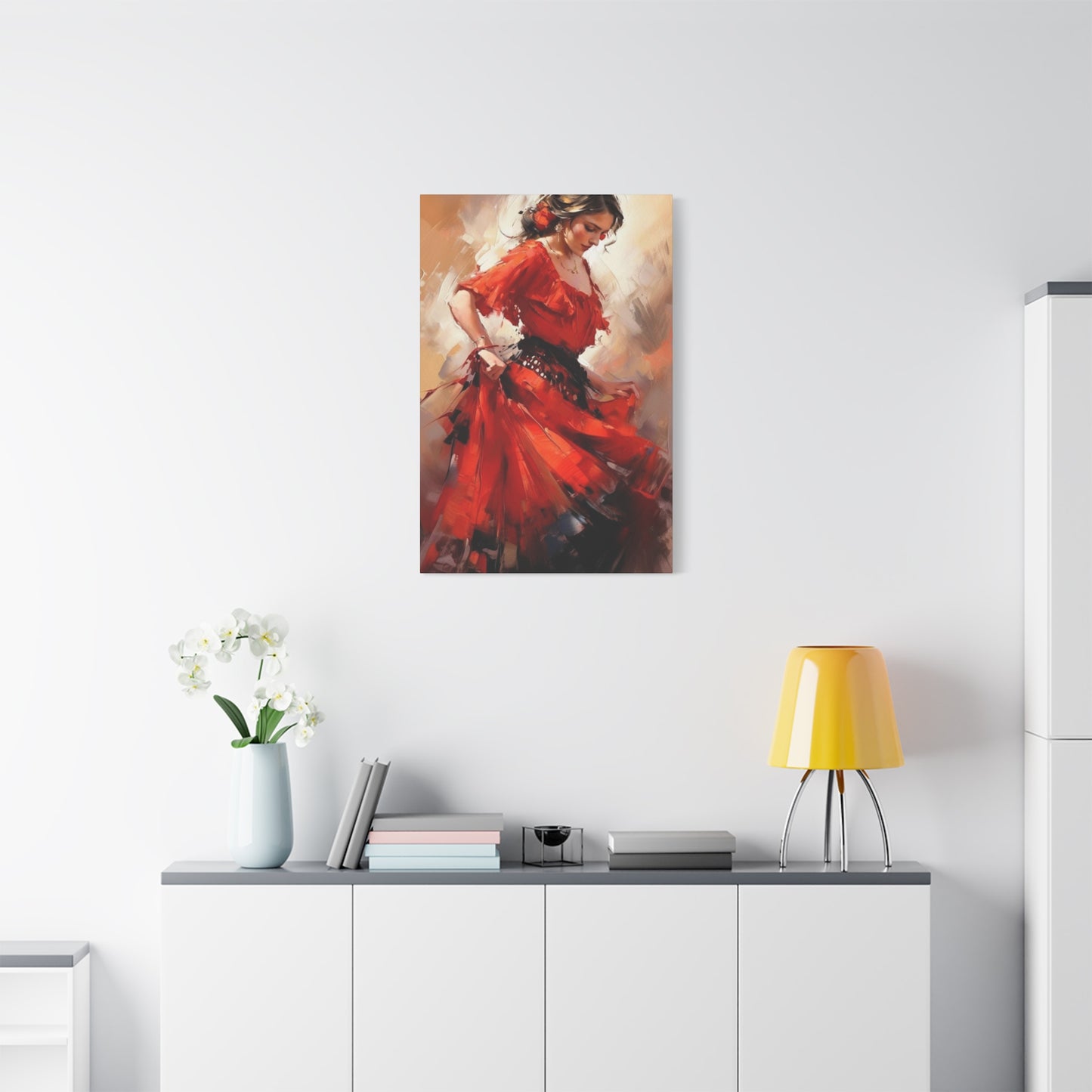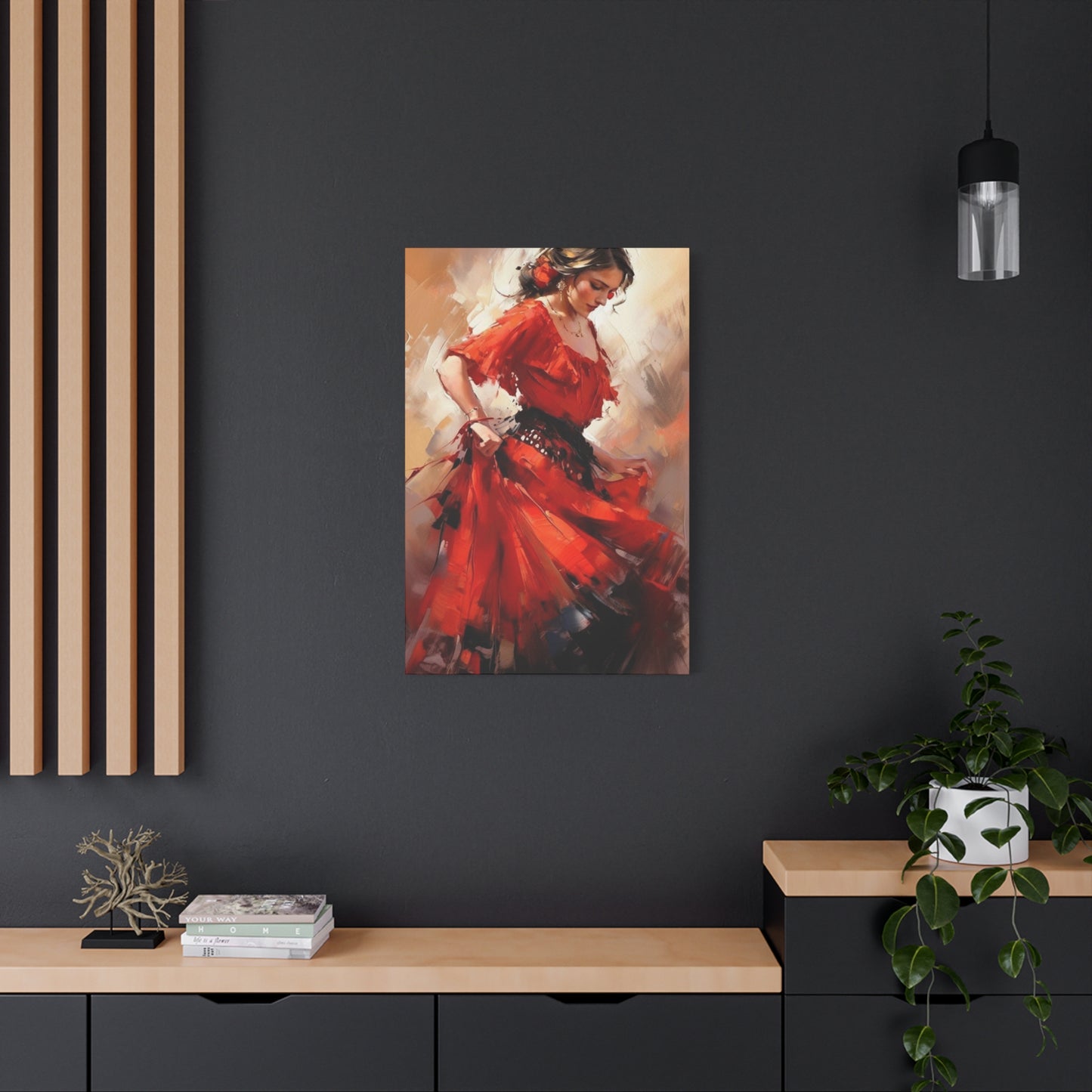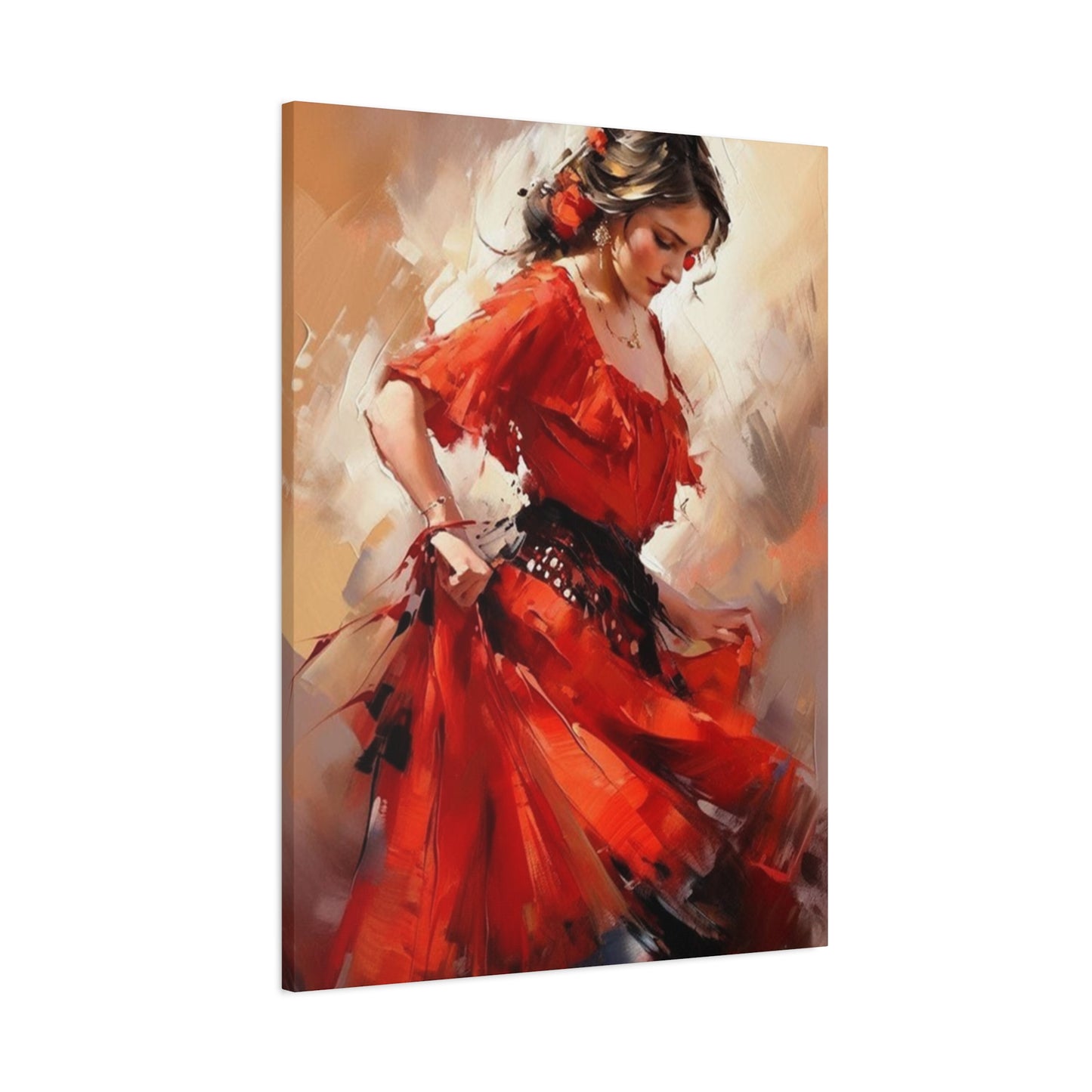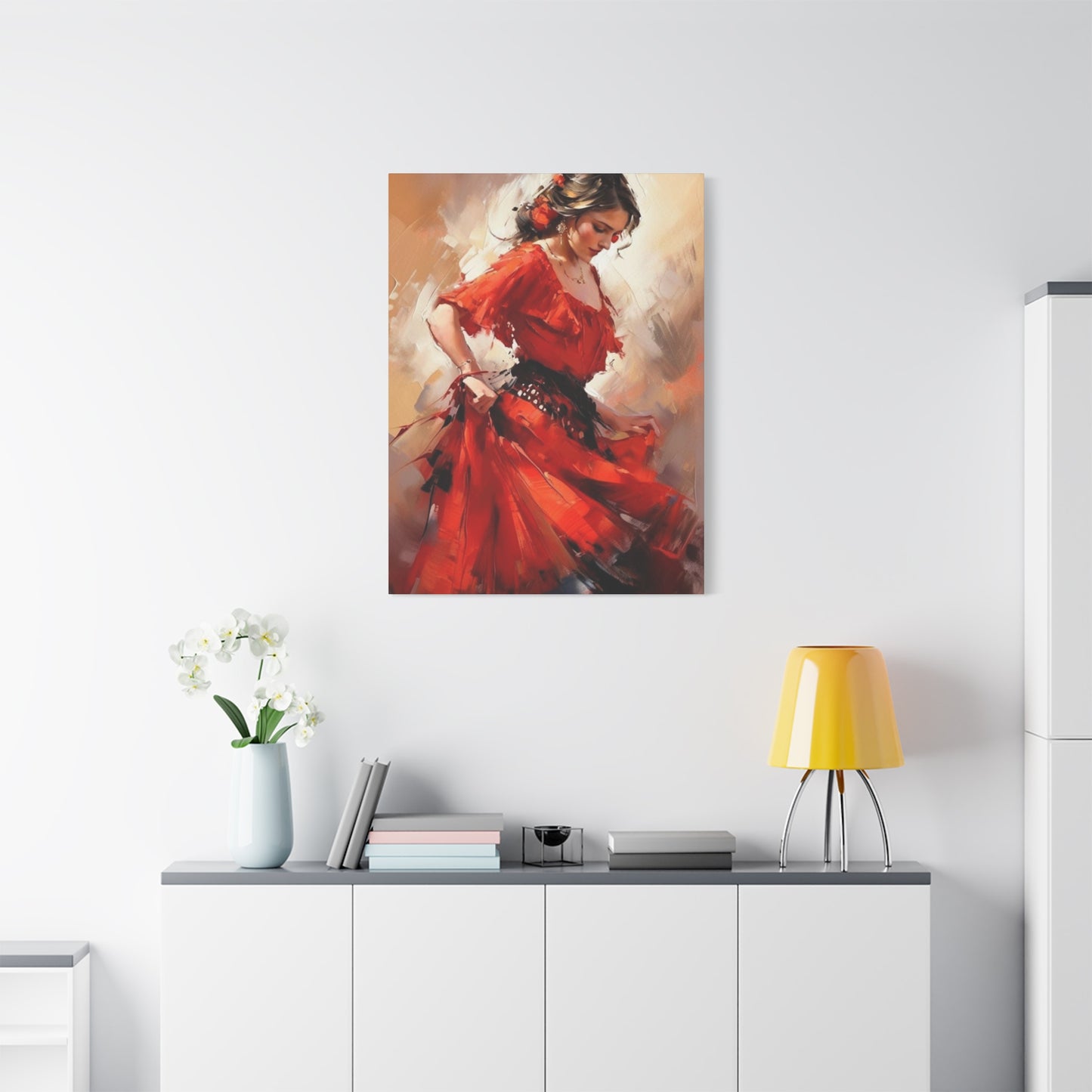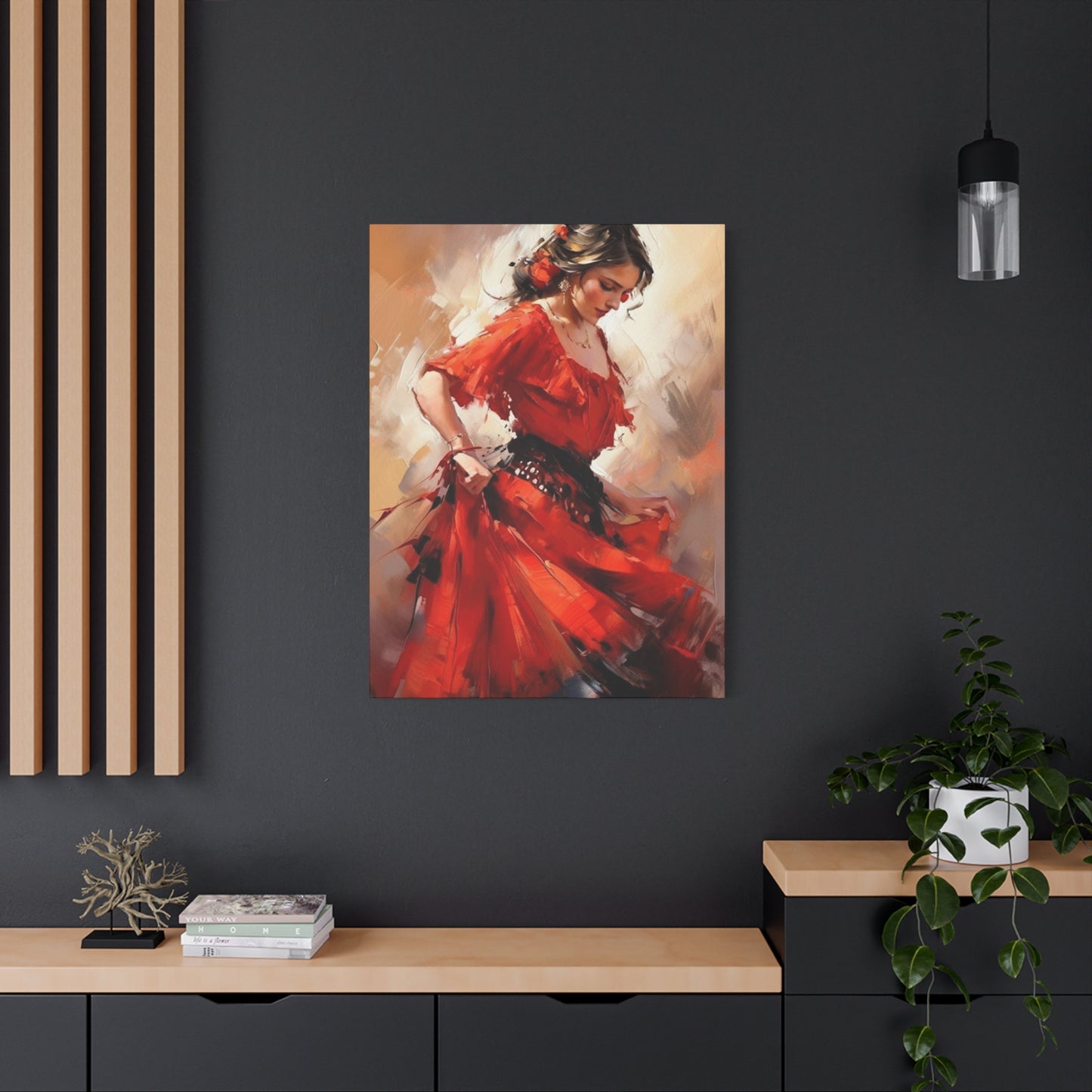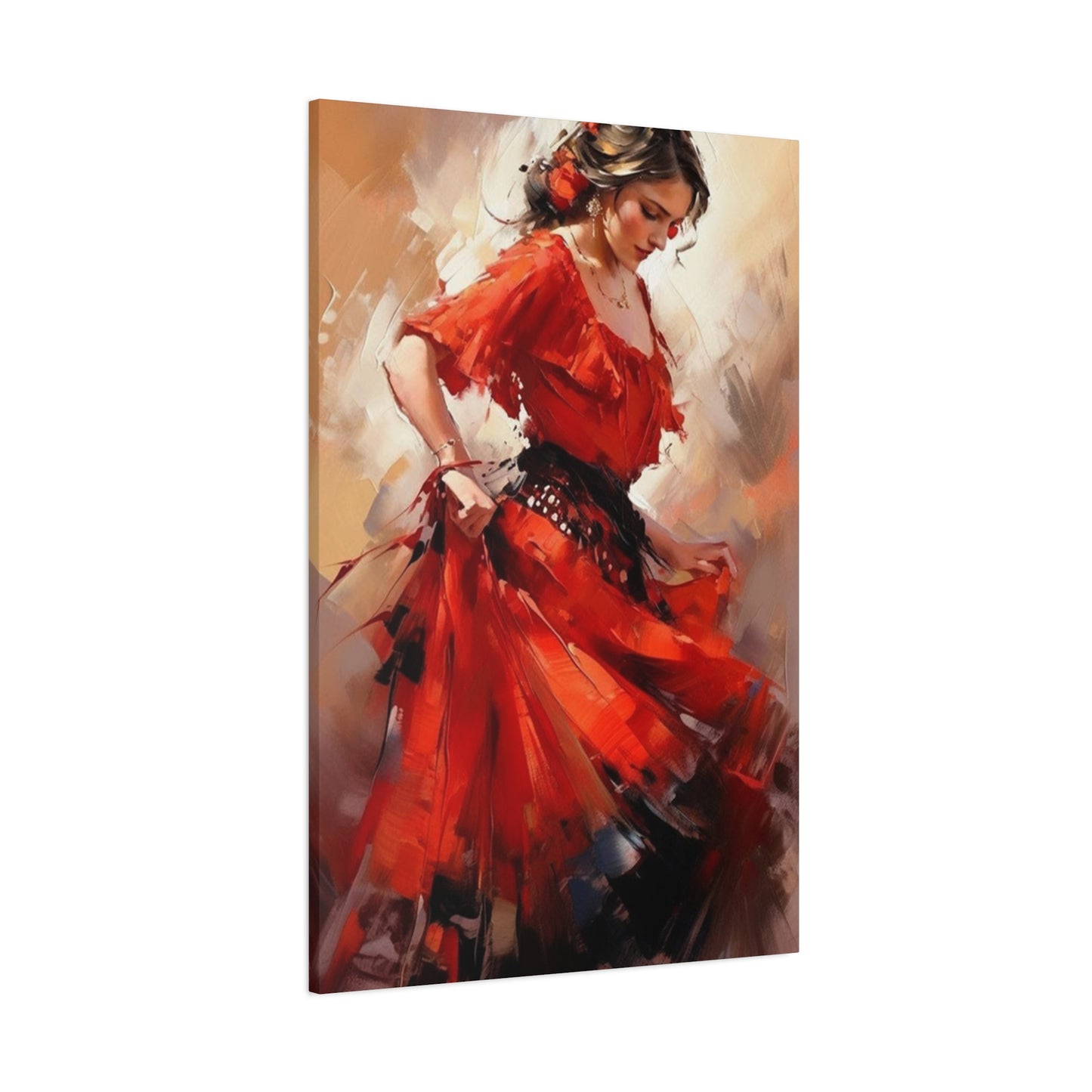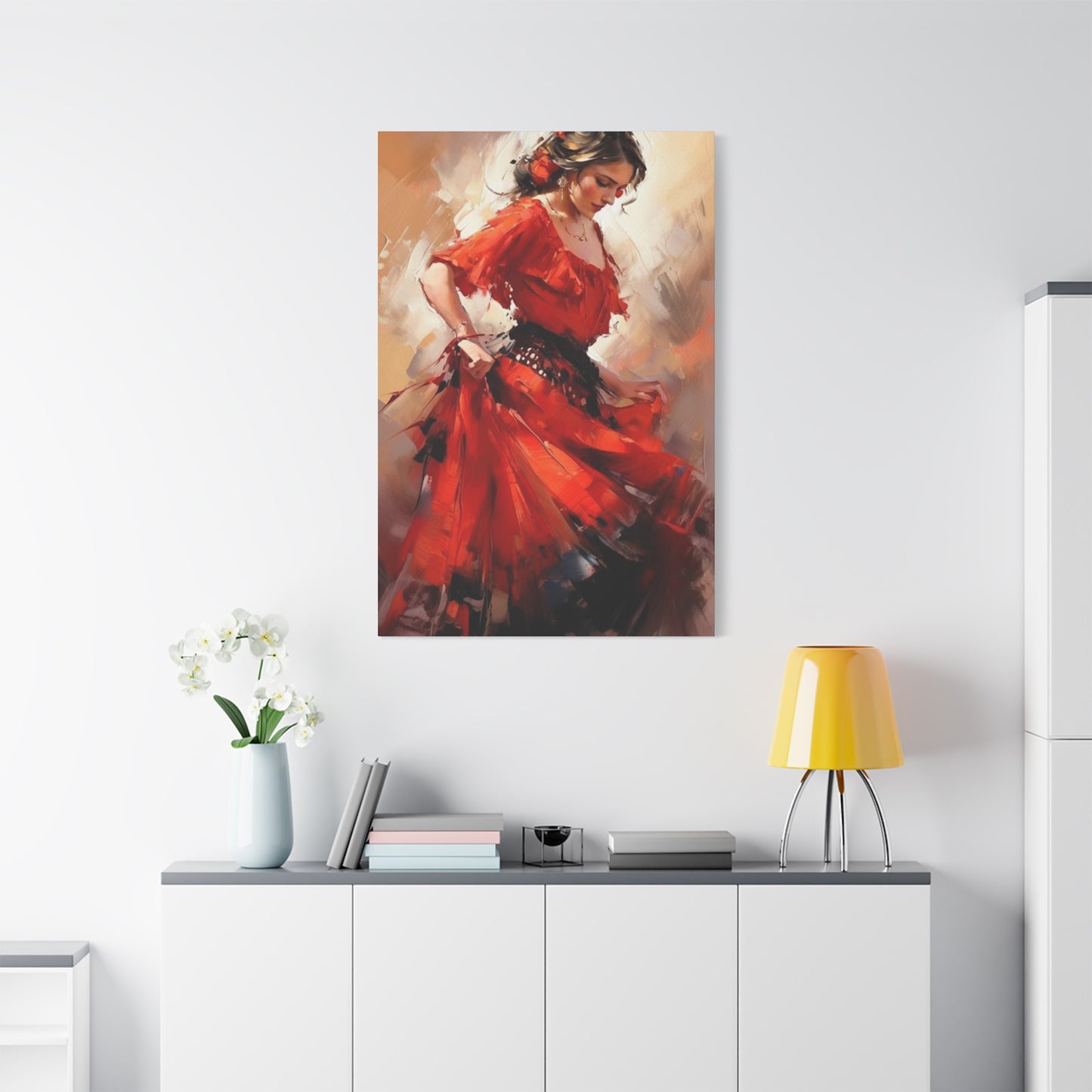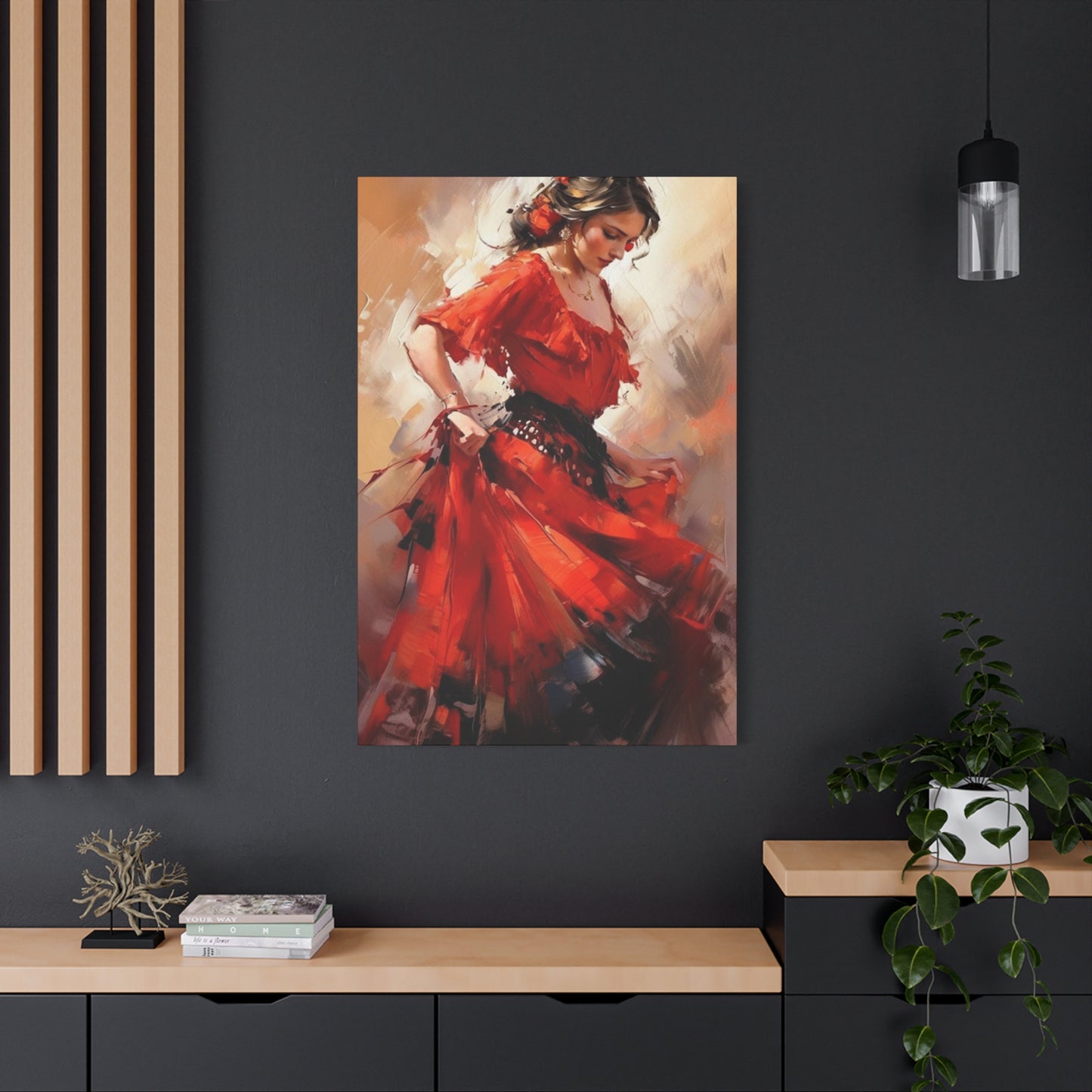The Cultural Significance of Spanish Traditional Red Dance Wear Wall art in Modern Interior Design
The timeless allure of Spanish traditional red dance wear has transcended its original performative context to become a celebrated element in contemporary wall art and home decoration. These stunning visual representations capture the passionate spirit of Iberian culture, embodying centuries of artistic tradition through bold crimson fabrics, intricate ruffles, and dramatic silhouettes that have defined Spanish dance for generations. When incorporated into wall decor, these images serve as powerful focal points that infuse any living space with warmth, energy, and cultural sophistication.
The popularity of Spanish dance-themed wall art stems from its ability to evoke strong emotional responses while adding sophisticated visual interest to residential and commercial interiors. The vibrant red tones characteristic of traditional flamenco dresses create instant visual impact, drawing the eye and establishing a sense of drama within any room. These decorative pieces work exceptionally well in various settings, from modern minimalist apartments seeking a bold accent piece to traditionally decorated homes that appreciate classical artistic expression.
Interior designers frequently recommend Spanish red dance wear wall art for spaces requiring energetic enhancement without overwhelming existing decor schemes. The inherent elegance of these garments, combined with their rich cultural heritage, makes them suitable for diverse aesthetic preferences. Whether displayed in living rooms, dining areas, hallways, or even professional office environments, these artistic representations bring a touch of Mediterranean passion to everyday surroundings.
The versatility of this decorative theme allows for multiple interpretative approaches. Some wall art pieces focus on close-up details of fabric textures, showcasing the elaborate ruffles and layered construction that make these costumes architectural marvels. Others present full-figure compositions capturing dancers mid-movement, freezing moments of passionate expression that define flamenco performance. Still others adopt more abstract approaches, using the red dress as a starting point for artistic exploration that emphasizes color, form, and emotional resonance over literal representation.
Flamenco Dance Costumes and Their Artistic Representation
The journey of Spanish traditional red dance wear from functional performance costume to celebrated wall art subject reflects broader cultural shifts in how societies value and preserve their artistic heritage. Flamenco dance, originating in the Andalusian region of southern Spain during the 18th century, developed as a fusion of Romani, Moorish, Jewish, and native Andalusian cultural influences. The distinctive costumes worn by dancers evolved alongside the dance form itself, with each element serving both practical and aesthetic purposes.
Early flamenco costumes were relatively simple, reflecting the working-class origins of the dance form. Women typically wore everyday dresses adapted for performance, often featuring the tiered ruffles that allowed freedom of movement while accentuating the hip and leg motions central to flamenco technique. As the dance gained recognition and moved from informal gatherings to formal stage presentations during the late 19th and early 20th centuries, costumes became increasingly elaborate and standardized.
The predominance of red in traditional Spanish dance costumes carries multiple layers of significance. Red symbolizes passion, intensity, and the fiery spirit that characterizes flamenco performance. It also references the rose, a recurring motif in Spanish culture representing beauty, love, and the bittersweet nature of human experience. Additionally, the color connects to Spain's historical identity, appearing in national symbols and regional traditions throughout the Iberian Peninsula.
Artists have long been captivated by the visual drama of flamenco dancers and their striking costumes. Spanish painters of the 19th and early 20th centuries, including Joaquín Sorolla and Julio Romero de Torres, frequently depicted dancers in their works, recognizing the potent combination of cultural authenticity and aesthetic appeal these subjects provided. These paintings helped establish the iconic imagery that continues to influence contemporary wall art designs featuring Spanish traditional red dance wear.
Photography emerged as another important medium for capturing and disseminating images of flamenco costumes. Early photographers documented performances and portrait sessions with dancers, creating a visual archive that would inform artistic interpretations for decades to come. The dramatic contrasts inherent in flamenco imagery, with dark hair and intense expressions set against brilliant red fabrics, proved particularly well-suited to photographic reproduction, enhancing the popularity of these images.
Spanish Red Dance Wear Wall Art Visually Striking
The exceptional visual impact of Spanish traditional red dance wear wall art derives from several key design elements that work in harmony to create compelling compositions. Understanding these components helps both artists creating such pieces and consumers selecting them for their spaces appreciate what makes these decorative items so effective at transforming interior environments.
Color dominance represents perhaps the most immediately noticeable characteristic of this art category. The bold crimson, scarlet, and ruby tones typical of traditional flamenco dresses command attention in any setting, creating instant focal points that anchor room designs. These warm reds possess inherent psychological properties that stimulate energy and passion, making spaces feel more dynamic and emotionally engaging. The intensity of these hues also means that even relatively small pieces can have significant visual impact, making Spanish red dance wear wall art particularly effective for accent purposes.
The interplay between red primary elements and supporting colors contributes significantly to overall compositional success. Many effective pieces incorporate complementary tones such as blacks, which appear in dancer's hair, shoes, and sometimes dress accents, creating dramatic contrasts that enhance visual depth. White elements, often present in petticoats or occasionally as dress details, provide luminous counterpoints that prevent compositions from feeling too heavy or monochromatic. Some artists introduce additional colors like gold accents, which reference the ornate jewelry often worn with flamenco costumes, or softer background tones that allow the red garments to stand out more prominently.
Texture and dimensional quality distinguish exceptional Spanish dance wear wall art from ordinary reproductions. The inherent three-dimensionality of actual flamenco dresses, with their multiple layers of ruffled fabric creating complex shadows and highlights, presents both challenges and opportunities for two-dimensional artistic representation. Skilled artists and photographers capture these textural qualities through careful attention to lighting and compositional angles that emphasize the architectural nature of the garments. Some wall art employs actual dimensional elements, such as fabric additions to canvas prints or sculptural metal work that physically projects from the wall surface, creating enhanced visual interest through genuine three-dimensionality.
Movement and dynamism characterize the most compelling Spanish traditional red dance wear wall art. Flamenco is fundamentally a dance form defined by dramatic gestures, rapid footwork, and expressive body positioning, and effective wall art captures this kinetic energy even in static form. Artists achieve this through various techniques, including compositional choices that suggest motion through off-balance poses or mid-gesture captures, blurred elements that imply movement, and dynamic arrangements of fabric that appear to be swirling or falling rather than static. These approaches transform costume images from simple documentation into evocative artistic statements that communicate the passionate spirit of flamenco performance.
Perfect Spanish Dance Wall Art for Different Interior Styles
Matching Spanish traditional red dance wear wall art with specific interior design styles requires consideration of both the artwork's characteristics and the existing aesthetic environment. The versatility of this art category allows successful integration into surprisingly diverse decorative schemes when approached with awareness of design principles and aesthetic compatibility factors.
Contemporary minimalist interiors benefit tremendously from the bold visual impact of Spanish red dance wear wall art. The clean lines and neutral color palettes typical of minimalist design create perfect backdrops for the dramatic pop of color these pieces provide. In such settings, selecting artwork with simple compositions, minimal background detail, and strong geometric qualities works best. A single large canvas featuring an abstract interpretation of a red flamenco dress against a white or black background can serve as the sole art piece in a minimalist room, providing necessary visual interest without cluttering the streamlined aesthetic. The key to success in minimalist environments lies in restraint, allowing the artwork's inherent drama to stand alone rather than competing with multiple decorative elements.
Traditional and classic interior styles embrace Spanish dance wear wall art with equal enthusiasm, though different selection criteria apply. In traditional settings featuring rich woods, ornate furniture, and classical architectural details, framed prints or paintings with more elaborate compositions work well. Pieces showing full-figure dancers in authentic performance contexts, complete with period details and contextual backgrounds, complement traditional decor's appreciation for cultural heritage and historical authenticity. Gold or ornately carved frames enhance the classical presentation, helping the artwork integrate with other traditional decorative elements while maintaining its distinctive character. The warm red tones of the costumes harmonize beautifully with the wood finishes and rich fabric textures common in traditional interiors.
Mediterranean and Spanish colonial design styles represent natural homes for traditional red dance wear wall art, as they share direct cultural connections with the artwork's origins. These interior styles typically feature warm color palettes including terracotta, ochre, and cream tones that complement rather than compete with the vibrant reds in dance costume imagery. Textured wall surfaces, exposed wood beams, and wrought iron details characteristic of Mediterranean design create authentic contexts that enhance the cultural resonance of Spanish dance themes. In these settings, multiple smaller pieces arranged in gallery walls or paired configurations work particularly well, creating visual narratives that celebrate Spanish cultural heritage through accumulated imagery.
Materials and Manufacturing Techniques for Quality Spanish Dance Wall Art
The production quality of Spanish traditional red dance wear wall art varies tremendously based on materials employed and manufacturing techniques utilized. Understanding these factors helps consumers make informed purchasing decisions that balance aesthetic goals, budgetary constraints, and longevity expectations.
Canvas prints represent one of the most popular formats for Spanish dance wear wall art, offering several advantages that explain their widespread adoption. Quality canvas materials, typically cotton or polyester blends, provide texture that adds visual interest while supporting vibrant color reproduction. The fabric surface creates a traditional fine art appearance that many consumers find more sophisticated than paper prints. Canvas naturally resists glare from ambient lighting, allowing comfortable viewing from various angles without reflective interference. Gallery-wrapped canvas, where the image extends around the frame edges, creates finished presentations that need no additional framing, reducing both cost and installation complexity.
Manufacturing quality in canvas prints depends significantly on printing technology employed. Giclée printing, which uses archival-quality inks applied through specialized inkjet printers, produces superior color accuracy, subtle tonal gradations, and excellent longevity compared to standard digital printing. Genuine giclée prints of Spanish dance imagery should feature deep, rich reds that accurately capture the vibrancy of traditional costumes without oversaturation or artificial brightness. The ink should penetrate canvas fibers rather than sitting on the surface, ensuring durability against fading, scratching, and environmental factors. Consumers should verify that canvas prints use UV-resistant inks and materials rated for decades of display without significant deterioration.
Metal prints offer contemporary alternative presentations for Spanish red dance wear wall art with distinct aesthetic and practical characteristics. These pieces feature images infused into specially coated aluminum panels through dye-sublimation processes that create exceptionally vibrant, almost luminous color reproduction. The metallic surface imparts unique depth and brilliance to reds, making them appear to glow with internal light. Metal prints resist fading, moisture, and physical damage far better than canvas or paper, making them ideal for high-humidity environments like bathrooms or coastal locations. The modern, sleek appearance suits contemporary interiors particularly well, though may feel too industrial for traditional decorating schemes.
Acrylic-mounted photographs provide premium presentation options that showcase Spanish dance imagery with museum-quality sophistication. This production method involves mounting photographic prints behind clear acrylic panels, typically one-quarter to one-half inch thick, creating dimensional pieces with exceptional color depth and vibrancy. Light passes through the acrylic and reflects off the print surface, producing luminous effects that make reds appear particularly rich and saturated. The smooth, glossy acrylic surface requires careful placement to minimize glare but delivers stunning visual impact when properly positioned. These pieces command premium prices but offer corresponding quality levels that serious art collectors appreciate.
Framed paper prints maintain relevance in the Spanish traditional red dance wear wall art market despite competition from newer technologies. High-quality art paper, particularly cotton rag papers designed for fine art reproduction, provides excellent color rendering and archival stability when paired with appropriate inks. The matte or slightly textured surface of premium art paper creates sophisticated presentations that work particularly well in traditional or transitional interiors. Professional framing with archival matting and UV-protective glass significantly enhances both appearance and longevity, though increases cost and complexity. Consumers selecting framed prints should verify acid-free materials throughout the framing package to prevent deterioration that would compromise the artwork over time.
Installation and Placement Strategies for Maximum Visual Impact
Strategic installation of Spanish traditional red dance wear wall art significantly influences its effectiveness in transforming interior spaces. Proper placement considers multiple factors including viewing angles, lighting conditions, surrounding elements, and spatial proportions to ensure artwork achieves its full decorative and emotional potential.
Height positioning represents the most fundamental installation consideration, with general rules providing useful starting points that may require adjustment for specific circumstances. Art industry standards suggest centering artwork at eye level, typically 57 to 60 inches from floor to the piece's center point, matching average human sight lines for comfortable viewing. This guideline works well for artwork viewed primarily by standing viewers in hallways, entryways, or gallery-style displays. Spaces where people predominantly sit, such as living rooms or dining areas, benefit from slightly lower positioning that accounts for seated eye levels, perhaps centering pieces at 50 to 54 inches instead. Very large Spanish dance wear wall art spanning several feet vertically may need positioning that brings the composition's visual center, often the dancer's face or upper body area, to eye level rather than strictly centering the entire piece mathematically.
Lighting dramatically affects how Spanish red dance wear wall art appears and functions within spaces. Natural daylight brings out the full vibrancy and color subtlety of quality prints and paintings, making walls receiving good natural light prime locations for these bold pieces. However, direct sunlight presents fading risks even for UV-resistant materials, requiring thoughtful placement that provides illumination without prolonged direct sun exposure. Windows with sheer curtains or blinds that filter harsh rays while maintaining brightness offer ideal compromise solutions. Northern exposure windows in the Northern Hemisphere provide consistent indirect light throughout the day, creating excellent conditions for art display without significant fading concerns.
Artificial lighting requires equally careful consideration to properly illuminate Spanish traditional red dance wear wall art. Picture lights mounted above or below frames provide focused illumination that emphasizes artwork while creating dramatic visual hierarchy within rooms. LED picture lights offer energy efficiency and minimal heat output that prevents damage to delicate materials. Track lighting systems allow flexible positioning of multiple lights that can highlight individual pieces or create wash effects across gallery wall arrangements. Recessed ceiling lights positioned to graze wall surfaces create sophisticated illumination that brings out texture in canvas prints while minimizing glare on glass-fronted pieces. Avoiding lighting that creates harsh reflections on glossy surfaces or uneven illumination across artwork ensures optimal presentation under all viewing conditions.
Surrounding wall color influences how Spanish red dance wear wall art reads within spaces, creating either harmonious integration or dramatic contrast depending on design objectives. White and off-white walls create clean, gallery-style backdrops that allow vibrant red costumes to achieve maximum prominence, working particularly well in contemporary and minimalist interiors. Soft neutral tones including beiges, grays, and taupes provide warmth while still allowing artwork to stand out clearly, suitable for transitional and traditional spaces. Darker wall colors including deep grays, charcoals, or even black create sophisticated, moody environments where Spanish dance imagery appears to glow with internal luminosity, though require careful lighting to prevent spaces from feeling cave-like. Colored walls in blues, greens, or complementary tones can work well when selected thoughtfully, though risk competing with rather than enhancing the artwork if not carefully balanced.
Styling Spanish Dance Wall Art with Complementary Decor Elements
Color coordination represents the most obvious styling consideration, with several strategic approaches yielding successful results. Monochromatic schemes build entire room palettes around the red tones prominent in Spanish dance wear art, incorporating various shades and tints from pale blush to deep burgundy in upholstery, curtains, pillows, and accessories. This creates immersive, dramatically unified environments where the wall art feels like an organic extension of the overall design rather than an add-on element. Complementary color schemes pair the warm reds of dance costumes with cool greens, particularly deep forest or sage tones, creating sophisticated contrasts that make both colors appear more vibrant through juxtaposition. Analogous schemes combine red with neighboring wheel positions including oranges and purples, crafting harmonious blends that feel related yet varied. Neutral base schemes use extensive grays, blacks, whites, and beiges as primary colors, introducing the Spanish dance art as the sole significant color statement that dramatically pops against restrained surroundings.
Textile selections dramatically influence how Spanish red dance wear wall art integrates within spaces. Throw pillows incorporating red tones echoing costume colors create immediate visual connections between wall art and seating areas, pulling the design together cohesively. Patterns featuring Spanish or Mediterranean motifs including tile designs, floral patterns, or geometric shapes typical of Iberian architecture reinforce cultural themes without literal repetition. Curtain and upholstery choices in complementary or harmonizing colors frame the wall art appropriately, with lighter fabrics creating bright, energetic environments and darker selections producing more dramatic, intimate atmospheres. Texture variations including woven textiles, embroidered details, or fabric with visible depth reference the complex textile construction of actual flamenco dresses, creating subtle thematic connections that design-savvy observers appreciate.
Furniture style and finish choices should acknowledge the aesthetic character of Spanish traditional red dance wear wall art for maximum cohesion. Traditional carved wood furniture in dark finishes complements the classical heritage of flamenco culture, creating environments that honor historical authenticity. Contemporary furniture with clean lines and minimal ornamentation allows the dramatic wall art to remain the focal point without competing visual complexity. Mid-century modern pieces bridge traditional and contemporary sensibilities, their organic shapes and warm wood tones harmonizing well with Spanish dance themes. Painted furniture in complementary colors including black, white, or even matching reds can create bold, unified statements in eclectic or bohemian interiors where conventional coordination rules are deliberately challenged.
Creating Gallery Wall Displays with Spanish Dance Themes
Planning gallery wall layouts begins with gathering all pieces intended for display and arranging them on the floor in potential configurations before committing to wall installation. This experimental approach allows endless rearrangement without creating unnecessary wall damage from multiple nail holes. Photographing successful floor arrangements from above provides reference guides during actual installation. Creating paper templates matching frame sizes and taping them to walls allows visualizing arrangements in situ, accounting for furniture relationships, architectural features, and viewing angles that floor arrangements cannot replicate. Digital planning tools including specialized gallery wall apps or simple photo editing software enable virtual experimentation with arrangements, spacing, and proportions before physical implementation.
Compositional approaches to gallery walls vary from highly structured to freely organic, with successful results achievable through multiple strategies. Grid arrangements position frames in regular rows and columns with consistent spacing, creating orderly, contemporary presentations that work particularly well with identically sized and framed pieces. This symmetrical approach suits minimalist and modern interiors where clean geometry aligns with overall aesthetic preferences. Salon-style arrangements fill walls more organically with frames of varying sizes positioned to create overall balanced composition rather than regular patterns. This traditional approach accommodates diverse frame sizes and styles while achieving unity through careful attention to visual weight distribution and spacing relationships. Horizontal linear arrangements align frames along consistent horizontal axes while varying vertical positions, creating rhythmic presentations suitable for hallways or wall spans above furniture pieces.
Frame consistency decisions significantly influence gallery wall unity and character. Matching frames in identical style, color, and material create cohesive presentations where images relate clearly as intentional collections rather than random accumulations. This approach works particularly well when featuring Spanish traditional red dance wear wall art from single photographers, artists, or thematic series. Mixed frame styles incorporating various materials, colors, and profiles create more eclectic, collected-over-time appearances that suit bohemian, transitional, or informal interiors. When mixing frames, maintaining consistent mat colors or width proportions helps unify diverse pieces. Frame-free presentations with gallery-wrapped canvas prints create contemporary, streamlined appearances that emphasize images over presentation materials.
Size variation within gallery walls adds visual interest and accommodates available artwork options. Anchoring arrangements with one or two larger statement pieces creates focal points around which smaller images cluster. Symmetric size distribution balances larger pieces at layout centers or corners with progressively smaller works filling intermediate spaces. Asymmetric approaches intentionally place larger pieces off-center, counterbalancing their visual weight with groupings of smaller images. Maintaining some size consistency, perhaps including only two or three distinct frame sizes rather than every possible dimension, prevents arrangements from appearing chaotic or unplanned.
Spanish Dance Wall Art in Commercial and Professional Spaces
Restaurants emphasizing Spanish, Mediterranean, or Latin cuisines create authentic cultural environments with Spanish dance wear wall art that reinforces their culinary offerings' origins. These images establish immediate cultural context helping diners mentally prepare for flavor profiles and dining experiences ahead. The warm, passionate atmosphere created by red costume imagery enhances social dining experiences, encouraging conversation and extended stays that increase average checks. Strategic placement in entry areas creates memorable first impressions while installations throughout dining rooms maintain ambiance consistently. Durable materials including metal prints or canvas protected by clear coatings withstand commercial kitchen humidity and cleaning requirements better than unprotected paper prints. Themed gallery wall arrangements featuring multiple aspects of Spanish culture create immersive environments that differentiate establishments from generic competitors.
Hotels and resorts incorporate Spanish dance imagery to establish location identity or create distinctive aesthetic characters within individual rooms or public spaces. Lobbies benefit from large-scale statement pieces that create immediate arrival impressions and photo opportunities for social media sharing. Guest rooms featuring coordinated Spanish dance wall art in consistent styles or series create cohesive branded experiences across properties. Public spaces including corridors, elevators, and meeting rooms maintain thematic continuity when decorated with complementary dance imagery at various scales. Hospitality applications require particularly durable materials and secure mounting to withstand heavy traffic, cleaning procedures, and potential tampering. Replaceable standardized pieces allow efficient maintenance when damage occurs without custom matching challenges.
Cultural institutions including performing arts centers, museums, or language schools naturally embrace Spanish traditional red dance wear wall art as mission-aligned decoration. These environments benefit from educational approaches that provide context about flamenco history, costume construction, or cultural significance alongside aesthetic display. Gallery-quality presentations with professional framing and lighting demonstrate institutional commitment to artistic excellence while honoring displayed traditions. Rotating exhibitions prevent permanent displays from becoming stale for regular visitors while allowing broader exploration of themes. Interactive elements including QR codes linking to performance videos or audio explanations enhance engagement beyond purely visual appreciation. Donor recognition opportunities incorporating Spanish dance themes align fundraising needs with aesthetic goals.
Retail environments including home decor stores, art galleries, or boutiques showcase Spanish dance wear wall art as both decoration and merchandise. Display installations demonstrate styling possibilities helping customers envision pieces within their own spaces. Prominent positioning of best-selling or high-margin items maximizes commercial return from floor space investment. Seasonal rotations maintain visual freshness encouraging repeat visits from local customers. Point-of-purchase materials including printed room visualizations or styling guides support sales by reducing purchase uncertainty. Adequate inventory management prevents disappointing customers seeking displayed pieces while minimizing capital tied up in slow-moving stock.
Professional offices incorporate Spanish traditional red dance wear wall art to create distinctive, memorable environments that reflect organizational culture and values. Law firms, consulting companies, or creative agencies use culturally sophisticated artwork to convey worldly professionalism and aesthetic judgment to clients. Conference rooms benefit from discussion-worthy art that breaks ice during meetings while maintaining appropriate professional tone. Reception areas create positive first impressions with carefully selected pieces matching brand identity. Employee areas including break rooms or corridors benefit from energizing imagery that enhances workplace satisfaction. Professional applications require relatively conservative selections avoiding overly provocative or avant-garde interpretations that might offend diverse clients or staff.
Digital and Customizable Options for Personalized Spanish Dance Art
Print-on-demand services have democratized access to Spanish dance imagery by eliminating traditional inventory and distribution costs. Consumers browse extensive online catalogs featuring thousands of costume and dancer images from photographers and artists worldwide. Selecting desired images and specifying size, material, and finishing options through intuitive interfaces creates custom orders fulfilled within days. This model provides access to far more diverse imagery than traditional retail channels could economically stock. Quality varies significantly among print-on-demand providers, requiring research into reputation, material quality, and customer service before committing to purchases. Reading detailed reviews and ordering smaller test pieces before investing in large installations helps avoid disappointment from substandard production.
Custom photo printing transforms personal photographs from Spanish travel, flamenco performances, or cultural events into wall art with personal meaning impossible for generic commercial images to match. Professional photo printing services optimize image files for reproduction, correcting color balance, adjusting contrast, and resizing appropriately. Consultation services help non-photographers select best images from collections and determine optimal cropping and sizing for intended spaces. Advanced retouching removes distracting elements, repairs damage, or enhances colors while maintaining photographic authenticity. The resulting prints carry emotional significance beyond aesthetic appeal, representing actual experiences and memories rather than anonymous stock imagery.
Image customization and editing capabilities allow modifications to existing Spanish traditional red dance wear wall art designs, creating unique versions tailored to specific preferences. Changing background colors, adding text overlays, adjusting saturation or color tones, or combining multiple source images creates personalized versions distinct from mass-market alternatives. Graphic design software including Adobe Photoshop, Illustrator, or free alternatives like GIMP provides powerful tools for those with technical skills. Online design platforms with intuitive interfaces make customization accessible to non-designers through template-based systems and drag-and-drop functionality. Respecting copyright law remains essential when modifying others' images, with commissioned original artwork or properly licensed stock photography providing legal bases for derivative works.
Color customization allows matching Spanish dance wall art precisely to existing room color schemes. Changing dress colors from traditional reds to blues, purples, greens, or any desired hue creates coordinated looks impossible with standard photographs. Adjusting background tones ensures artwork complements rather than clashes with wall colors. Converting color images to black and white or sepia creates alternative moods while maintaining recognizable subject matter. Extreme color manipulations produce abstract effects that retain costume silhouettes while exploring pure color relationships. Digital tools make these modifications straightforward for those comfortable with image editing software or accessible through custom printing services offering personalization options.
Size flexibility represents a major advantage of digital Spanish traditional red dance wear wall art. Source image resolution permitting, digital files scale to virtually any dimensions required for specific installations. Panoramic formats create dramatic horizontal pieces suitable for long wall spans above furniture or in hallways. Vertical orientations fit narrow wall spaces or emphasize dancer height and costume length. Square formats work well in grid arrangements or as standalone statements. Oversized wall murals spanning entire walls create immersive experiences transforming rooms into cultural environments. Precise sizing eliminates awkward gaps or proportional mismatches between artwork and available wall space.
Composite and collage designs combine multiple Spanish dance images into unified compositions offering visual complexity beyond single images. Triptychs or multi-panel arrangements present related images across multiple canvases, creating segmented yet unified presentations. Photo collages combine numerous smaller images into mosaic-like overall shapes or patterns. Digital manipulation blends multiple source photographs seamlessly, creating impossible images that transcend documentary photography to become pure artistic creation. Text integration adds meaningful quotes, poetry, or personal messages to Spanish dance imagery, creating customized gifts or personally significant decoration. These advanced techniques require either personal technical skills or professional design services to execute effectively.
Augmented reality previewing helps consumers visualize Spanish traditional red dance wear wall art in their actual spaces before purchasing. Mobile apps use smartphone cameras to capture room views, then overlay digital representations of artwork at proper scale and positioning. This technology eliminates guesswork about whether pieces will fit appropriately or coordinate with existing decor. Trying multiple size options, materials, and frame styles virtually streamlines decision-making and reduces purchase regret. Some advanced systems adjust artwork color and lighting based on actual room conditions captured through cameras, providing remarkably accurate previews. While not perfect, these tools substantially improve outcomes compared to imagining appearances or relying solely on small web images.
The Role of Spanish Dance Art in Cultural Appreciation and Education
Flamenco dance represents invaluable intangible cultural heritage carrying centuries of accumulated artistic evolution and cultural significance. The distinctive costumes featured in wall art embody not merely aesthetic choices but meaningful cultural expressions developed through generations of performers. Each element from ruffle placement to color selection to accessory choices reflects conscious decisions rooted in tradition, practical performance needs, and artistic interpretation. Displaying Spanish dance wear imagery in homes and public spaces maintains visibility of these cultural traditions, preventing their fading into obscurity as younger generations engage less with traditional art forms. This preservation function operates subtly but significantly, keeping cultural awareness alive through constant visual presence.
Educational opportunities embedded in Spanish traditional red dance wear wall art emerge through conversations, research, and reflection prompted by displayed images. Guests inquiring about artwork receive informal cultural education as owners share knowledge about flamenco history, costume significance, or personal connections to Spanish culture. Children growing up with these images develop familiarity with cultural diversity and artistic traditions different from their own immediate heritage. Personal research into artwork origins, featured dancers, or costume details deepens owner understanding and appreciation beyond surface aesthetic enjoyment. These educational benefits multiply across society as more people engage meaningfully with cultural imagery rather than treating it as generic decoration.
Respect for cultural origins represents essential consideration when incorporating Spanish traditional red dance wear wall art into non-Spanish homes. While cultural appreciation and cross-cultural artistic engagement deserve celebration, avoiding cultural appropriation requires awareness and sensitivity. Appropriation occurs when dominant cultures extract superficial elements from marginalized cultures without understanding, respect, or reciprocity. Appreciation, conversely, involves genuine engagement seeking to understand and honor cultural significance while supporting source communities. Displaying Spanish dance imagery appreciatively means learning about flamenco history, acknowledging Spanish cultural contributions, and ideally supporting Spanish or flamenco artists through purchases rather than generic reproductions. Context matters, with thoughtful presentation and willingness to discuss cultural content distinguishing appreciation from appropriation.
Supporting living artists and cultural practitioners ensures Spanish traditional red dance wear wall art contributes positively to continuing traditions rather than merely memorializing past practices. Purchasing original artwork or authorized reproductions from contemporary flamenco photographers, painters, or dancers directly supports individuals keeping traditions alive. Attending live flamenco performances demonstrates engagement beyond passive image consumption. Participating in flamenco classes or workshops, even at beginner levels, develops embodied understanding of the dance form's physical and artistic demands. Financial contributions to flamenco preservation organizations or cultural institutions support broader maintenance of these artistic traditions. These actions transform wall art ownership from simple decoration into active cultural participation.
Cultural context education for children exposed to Spanish traditional red dance wear wall art develops appreciation for diversity and artistic excellence. Parents and educators can discuss costume construction, performance traditions, and cultural meanings age-appropriately. Watching video recordings of actual flamenco performances brings static images to life, demonstrating how costumes function in motion. Reading children's books about Spanish culture or flamenco dancers provides narrative context. Creating simple crafts inspired by Spanish costume elements engages hands-on learning. Attending family-friendly cultural performances builds experiential understanding. These educational approaches help children see displayed artwork as windows into living cultural traditions rather than just pretty pictures.
Historical context enriches understanding of Spanish traditional red dance wear wall art by situating costumes within broader cultural and political developments. Flamenco emerged from marginalized communities including Romani peoples facing discrimination and persecution throughout European history. The dance and its costumes represent cultural resistance, identity assertion, and artistic triumph over adversity. Understanding this history adds profound meaning to costume imagery, transforming appreciation from purely aesthetic to ethically and historically informed. Recognizing how traditional arts have survived persecution, modernization, and cultural homogenization pressures deepens respect for their contemporary persistence and the people maintaining them.
Gender and identity dimensions of Spanish traditional red dance wear merit thoughtful consideration. Flamenco costuming and performance traditionally emphasized distinct masculine and feminine presentations, with the elaborate dresses featured in most wall art representing women's performance traditions. Contemporary flamenco increasingly explores gender fluidity and non-binary expression while honoring traditional forms. Understanding these evolving dimensions prevents reductive or stereotypical interpretations. Appreciating how costumes enable powerful feminine expression while recognizing diversity within tradition creates nuanced understanding. Discussing these topics thoughtfully when gender and identity questions arise enriches cultural education beyond superficial costume appreciation.
Global influence of Spanish dance traditions demonstrates cultural interconnection and artistic cross-pollination that Spanish traditional red dance wear wall art can symbolize. Flamenco has influenced numerous international dance and music forms while incorporating elements from diverse traditions throughout its development. The costumes themselves show Arabic, Romani, and broader European influences synthesized into distinctive Spanish forms. Recognizing these transcultural dimensions counters simplistic nationalist narratives while celebrating authentic cultural synthesis. Wall art displaying these costumes can represent global artistic heritage and cultural exchange rather than narrow ethnic identification, supporting cosmopolitan worldviews.
Regional diversity within Spanish dance traditions adds complexity often overlooked in generalized red costume imagery. Different Spanish regions developed distinct dance styles with characteristic costume variations. Andalusian flamenco differs from northern styles, while regional festivals feature locally specific dress. Researching actual origins of depicted costume styles deepens understanding beyond generic "Spanish dance" categorization. This attention to specificity demonstrates genuine cultural respect and interest rather than superficial appropriation. Where possible, selecting wall art depicting specific regional traditions or identified performers enhances authenticity and educational value.
Contemporary relevance of traditional Spanish dance and costume in modern Spain and diaspora communities worldwide deserves recognition. These are not merely historical artifacts but living traditions actively performed, taught, and evolved by contemporary practitioners. Modern flamenco incorporates jazz, contemporary dance, and global music influences while maintaining cultural continuity with traditional forms. New generations of dancers reinterpret costume traditions through contemporary aesthetics while respecting essential elements. Understanding this ongoing vitality prevents regarding Spanish traditional red dance wear wall art as nostalgic documentation of dead traditions rather than celebrating living cultural practices with contemporary relevance.
Incorporating Spanish Dance Art into Specific Room Designs
Strategic incorporation of Spanish traditional red dance wear wall art varies significantly across different room types, with each space presenting unique opportunities and considerations that influence optimal selection and placement approaches.
Living room applications of Spanish dance wall art capitalize on these spaces' social functions and typical size allowing impactful large-scale installations. Positioning major pieces as focal points above sofas or fireplaces creates immediate visual anchors that establish room character. The energizing qualities of red costume imagery support living rooms' purposes as family gathering and entertaining spaces. Multiple coordinated pieces in gallery wall arrangements transform entire wall expanses into cultural statements. Balancing artwork prominence with furniture, lighting, and other decorative elements prevents overwhelming spaces while ensuring Spanish dance themes receive appropriate emphasis. Consider viewing angles from multiple seating positions to ensure artwork remains visible and effective throughout rooms rather than optimizing only for single vantage points.
Dining room installations benefit from Spanish traditional red dance wear wall art's cultural associations and appetite-stimulating warm color palette. The celebratory nature of flamenco aligns perfectly with dining as social ritual, enhancing meal experiences beyond simple nutrition. Positioning artwork where diners naturally gaze during conversation ensures engagement throughout meals. Lighting that illuminates both artwork and dining surfaces without creating uncomfortable glare serves dual functional purposes. In open-concept spaces combining dining and living areas, Spanish dance art helps define separate zones while maintaining visual continuity. Coordinate artwork colors with table linens, dishware, or centerpiece elements for special occasions, creating temporarily heightened thematic emphasis.
Kitchen applications of Spanish dance wall art add unexpected sophistication to often-utilitarian spaces while providing enjoyable visual interest during food preparation activities. Durable materials resistant to humidity, temperature fluctuation, and occasional splashing suit kitchen environments better than delicate options. Positioning away from direct cooking areas reduces exposure to grease and heat while maintaining visibility from work zones. Gallery walls in breakfast nooks or dining peninsulas create cozy, decorated eating areas within larger kitchens. The cultural associations with Spanish cuisine make dance-themed artwork particularly appropriate in kitchens, creating thematic coherence. Smaller scale pieces work better in typically crowded kitchen walls competing with cabinets, appliances, and functional elements for space.
Bedroom applications require careful consideration of Spanish traditional red dance wear wall art's energizing properties versus typical desires for calming sleep environments. When used in master bedrooms, positioning pieces where they're visible during waking hours but not dominant from bed creates appropriate balance. Guest bedrooms accommodate bolder installations since occupants experience them less continuously than primary residents. Selecting pieces with softer red tones or significant balancing neutral colors prevents overstimulation. Positioning artwork above dressers or on walls perpendicular to beds rather than directly facing sleepers creates engaging decoration without sleep interference. Romantic associations with passionate flamenco can enhance couple bedroom atmospheres when incorporated thoughtfully.
Home office installations of Spanish dance wall art provide inspirational, culturally sophisticated decoration supporting creative and intellectual work. The passionate expressiveness of flamenco imagery encourages bold thinking and confident decision-making beneficial in professional contexts. Positioning pieces within natural sight lines from desk positions provides enjoyable viewing during mental breaks without becoming distracting during focused work. Color psychology suggests red may increase productivity and energy in work environments, making Spanish dance themes potentially beneficial for home offices. Avoiding overly provocative or elaborate pieces maintains professional atmosphere appropriate for video conference backgrounds or client meetings in home offices.
Conclusion
In conclusion, “The Cultural Significance of Spanish Traditional Red Dance Wear Wall Art in Modern Interior Design” highlights the profound impact that vibrant cultural symbols can have on contemporary living spaces. Spanish traditional red dance wear, especially associated with flamenco, is more than just a stunning visual motif—it embodies passion, intensity, and a rich heritage that resonates deeply with audiences worldwide. When translated into wall art, this iconic red attire breathes life and cultural depth into modern interiors, transforming them into expressive, dynamic environments.
Red, in Spanish dance, is a color charged with symbolism. It represents energy, love, courage, and the fiery spirit of flamenco. This emotional resonance is what makes red dance wear such a powerful subject for wall art. Beyond its aesthetic appeal, it carries a story of tradition, artistry, and emotional expression that adds a layer of meaning to any room. Incorporating this art into modern interiors invites an immersive cultural experience that both honors and celebrates Spain’s artistic legacy.
From a design perspective, red dance wear wall art introduces a bold splash of color that can dramatically influence a space’s atmosphere. In minimalist and contemporary settings, such art becomes a captivating focal point, breaking the monotony of neutral tones with its vivid vibrancy. In eclectic or bohemian interiors, it complements other rich textures and patterns, enhancing the space’s warmth and personality. This versatility allows the artwork to harmonize with various décor styles while maintaining its distinct cultural identity.
Moreover, the imagery of traditional Spanish dance wear encourages a connection to movement, rhythm, and emotion. It serves as a reminder of the human stories behind the dance—the passion, the struggle, and the celebration. This narrative quality adds emotional depth to interior spaces, making them not just visually appealing but also profoundly engaging on a personal level.
Incorporating Spanish traditional red dance wear wall art also promotes cultural appreciation and awareness. It provides an opportunity to share the beauty and significance of flamenco and Spanish heritage with guests and family, sparking conversations and fostering a deeper understanding of global artistry.
Ultimately, embracing this type of wall art in modern interior design is about more than decoration; it’s about bringing cultural richness, emotional vibrancy, and artistic passion into everyday environments.In essence, Spanish traditional red dance wear wall art transforms interiors into living celebrations of culture, emotion, and timeless artistry—creating spaces that are as bold and passionate as the dance itself.


















